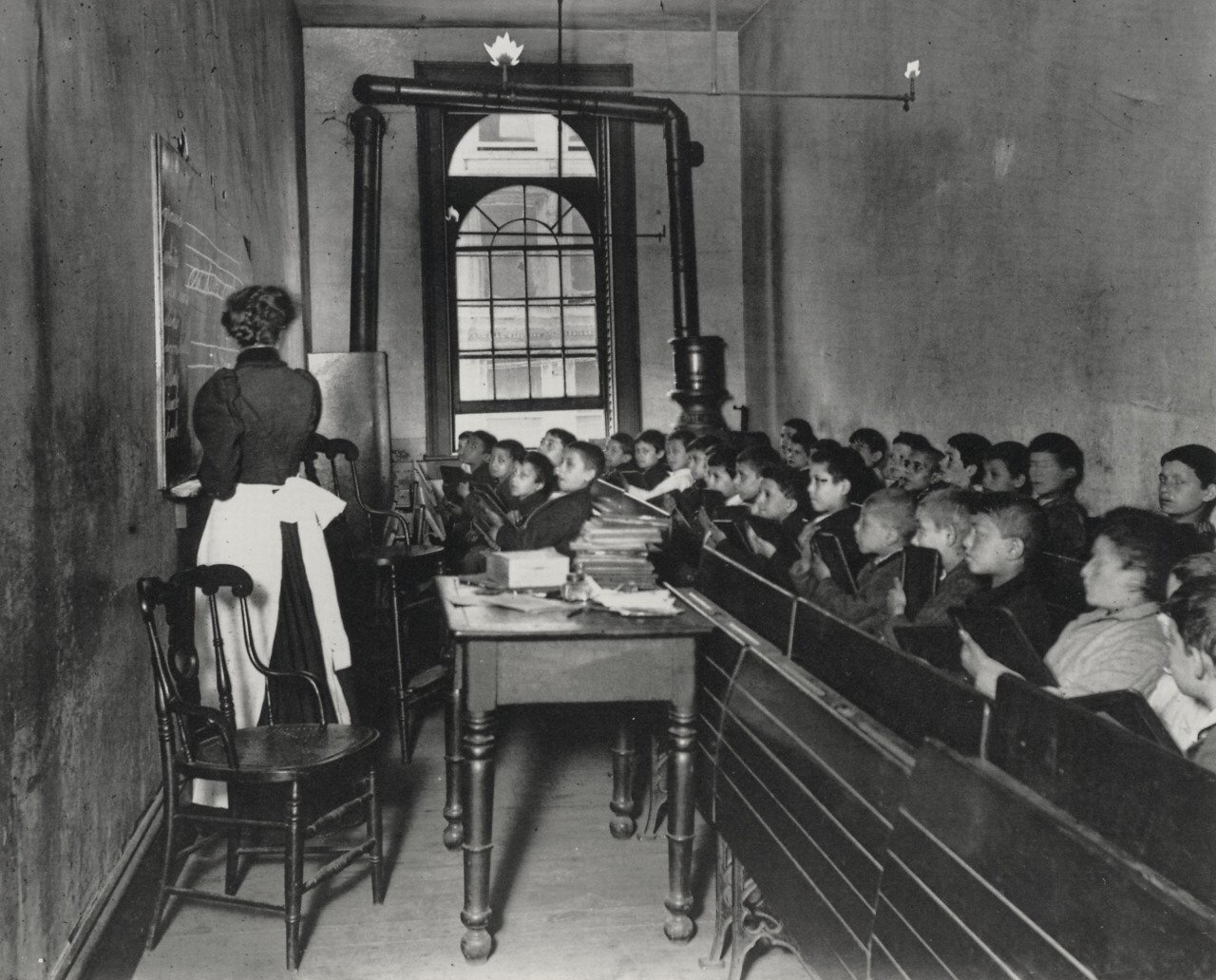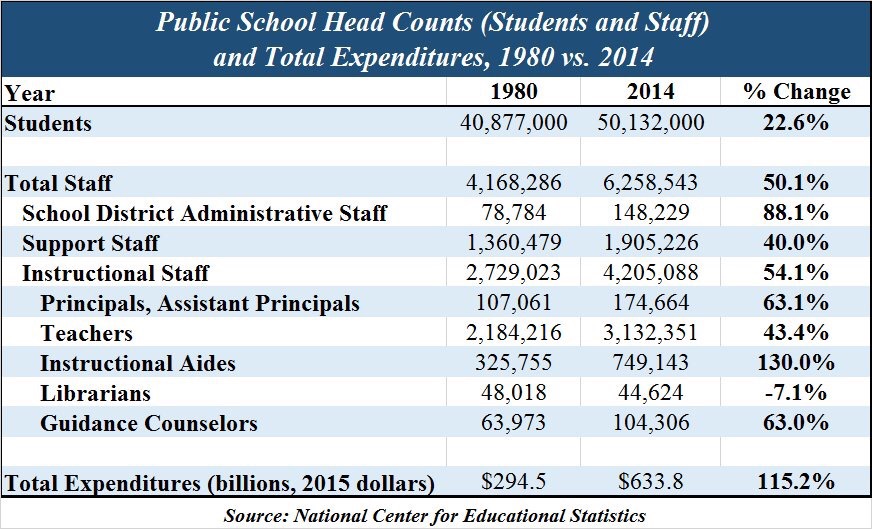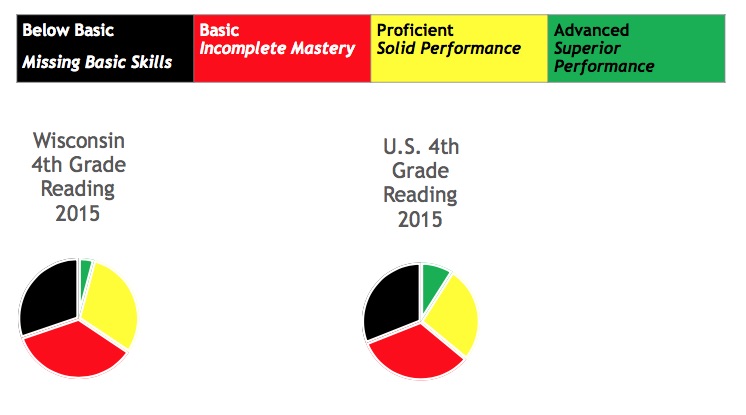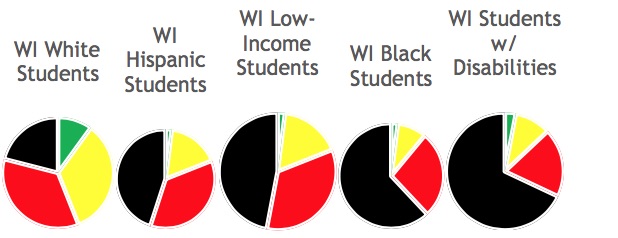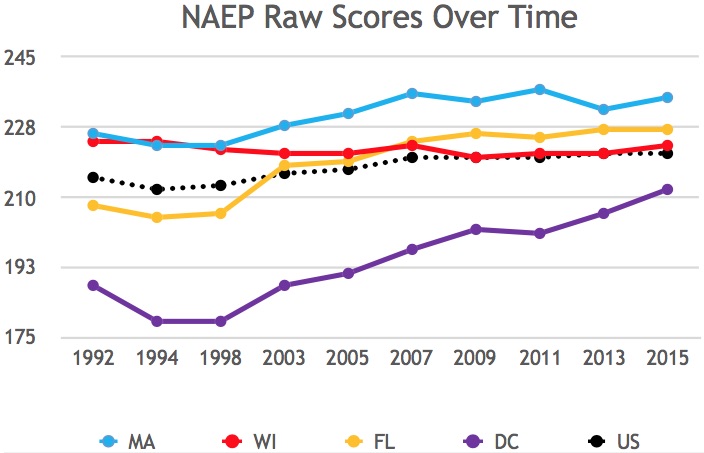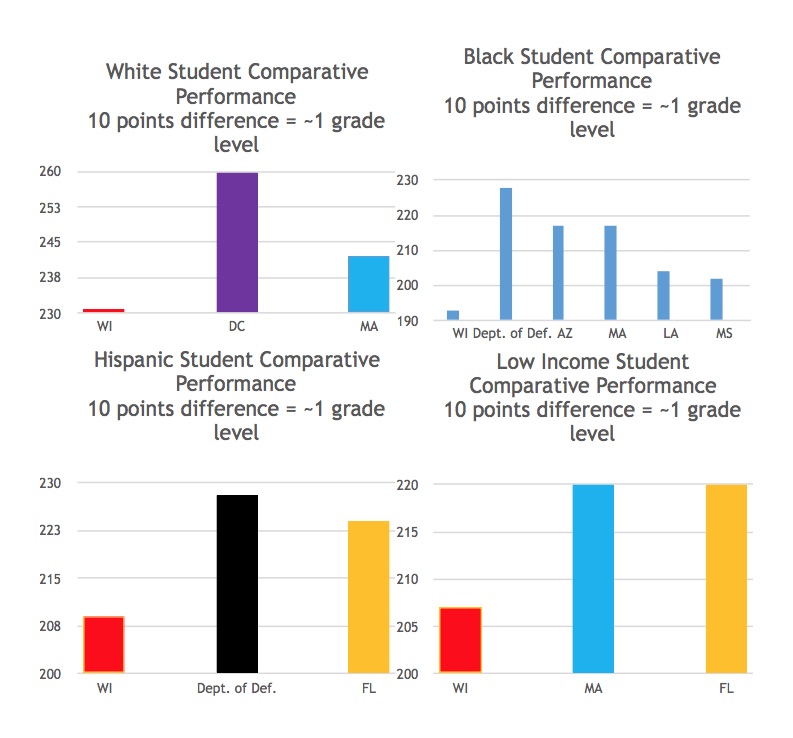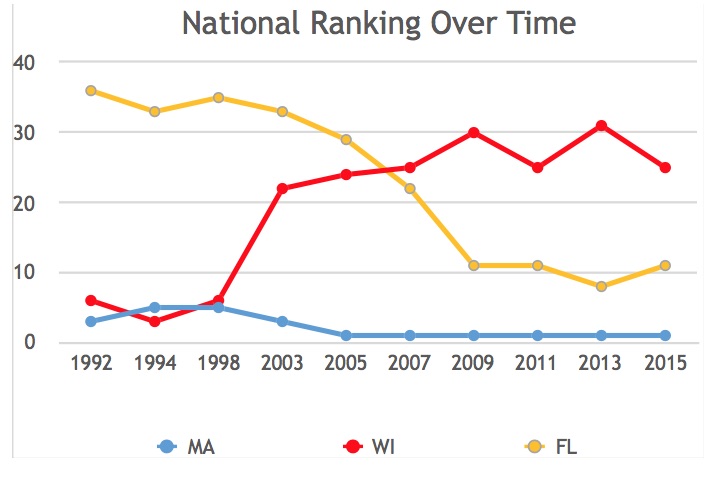Wisconsin Reading Coalition, via email:
On January 27th, the Leadership Group on School Staffing Challenges, convened by DPI Superintendent Tony Evers and Wisconsin Association of School District Administrators (WASDA) Executive Director Jon Bales, issued its Full Summary of Preliminary Licensing Recommendations. Together with earlier recommendations from the State Superintendent’s Working Group on School Staffing Issues and the Wisconsin Talent Development/Professional Standards Council Strategic Plan, this document identifies the Wisconsin Foundations of Reading Test (WIFoRT) as a roadblock to licensure for potential teachers.
The WIFoRT, written into State law in 2012, is supposed to be a roadblock to licensure for those who cannot pass it, as it objectively measures a candidate’s knowledge of the foundations of reading acquisition and effective pedagogical approaches. Given our stagnant reading scores since 1992, our low reading proficiency rates, the large gaps in proficiency between different subgroups of students, and our diminished national ranking in reading performance, the legislature agreed with the Read to Lead task force that something needed to be done. The WIFoRT was selected as one way to improve reading education for our children.
The WIFoRT, along with the requirement that student passage rates be reported annually, serves three purposes:
- Provides incoming college students and their families with comparative WIFoRT passage rates for all institutions of higher education
- Assures that new teachers are equipped to effectively teach reading (practicing teachers are not covered)
- Serves as a litmus test on the quality of teacher preparation in reading in our colleges of education
WIFoRT passage rates have not yet been published by DPI or the individual teacher preparation programs (though the test has been required since January of 2014), so our incoming college students lack this information in comparing programs.
The three reports referenced above indicate that inadequately prepared teachers are in fact not being licensed. While that is unfortunate for those aspiring teachers, and reduces number of the candidates in the hiring pool, it is also safeguarding our young and struggling readers by imposing some minimum quality assurances.
Based on the groups’ concerns over the WIFoRT failure rates, we can surmise that there is room for improvement in our teacher preparation programs when it comes to reading. The WIFoRT is a rigorous but not impossible test. A well-prepared college student should not have trouble passing. However, none of these reports addresses improving the standards for teacher preparation. Instead, they suggest lowering the cut score, changing state statutes, putting teachers in charge of classrooms without passing the exam, and allowing unspecified alternative ways to judge a teacher’s competency in foundational reading skills.
Once again, we see our DPI and its advisory groups prioritizing adults over children, and seeking to hide or ignore uncomfortable facts. This is unfair to Wisconsin children as well as potential teachers who deserve to be adequately prepared. If you expect better from our state educational agency, be sure to vote in the February 21st primary and the April general election for state superintendent.
Complete Wisconsin Reading Coalition Commentary “DPI’s Response to Reading Educator Preparation Problem is a Case Study of Evers’ Tenure: Obfuscate the Evidence Rather than Solve the Problem”:
It seems to be official: too many potential educators are failing the Wisconsin Foundations of Reading Test (WIFoRT). It’s been difficult to find this information. We have yet to see any of the statutorily-required annual reports listing passage rates for the WIFoRT, first given in 2014. Allowing itself 2-1/2 years to get results posted, DPI is still working on the 2012-13 year, and individual campuses are following suit. However, three separate DPI-convened groups in the past year have identified WIFoRT as a significant impediment to aspiring educators receiving initial teaching licenses. There must be a problem here. Some relevant quotes:
- “Members asserted that otherwise qualified candidates struggle to pass the state-required reading exam, reducing the supply of potential educators in certain disciplines.”
- The State Superintendent’s Working Group on School Staffing Issues, Final Report, June, 2016 “State statute 118.19 (14) (a) went into effect January 30, 2014 which requires special education teachers to pass the Foundations of Reading Test for Wisconsin. This additional requirement may cause some teacher candidates to take longer to complete preparation programs in order to post a passing score on the test.” Wisconsin Talent Development Framework/Professional Standards Council Strategic Plan Recommendations Draft, November, 2016
- “Members also raised significant concerns about the Foundations of Reading Test (FoRT). While members acknowledged the importance of raising the knowledge and preparation level of all elementary and special education teachers in teaching reading, they also cited the law’s rigidity as a significant barrier to entry. Without a waiver policy or other flexibility, students who have been successfully trained and are sought by school districts are currently unable to achieve full licensure unless they pass this exam. This lack of flexibility is of increasing concern, particularly as recent law changes allow a teacher prepared out of state with only one year of teaching experience to become eligible for a teaching license in Wisconsin without passing the FoRT exam. . . . [T]here are candidates currently on emergency licensure who have completed every portion of their preparation except for successfully passing this exam.” Leadership Group on School Staffing Challenges, January, 2017
Let’s be clear: the WIFoRT is doing exactly what it is intended to do: assuring that new teachers in our elementary children’s classrooms, plus new special education teachers, reading teachers, and reading specialists, have a minimum of competency in the critical area of reading. State law requires these potential educators to pass the WIFoRT before obtaining an initial teaching license and becoming responsible for the reading education of our students. We wish that out-of-state teachers coming to Wisconsin with just one year of experience were held to the same standard.
The WIFoRT is identical to the MTEL 90 reading test pioneered in Massachusetts and now used in other states. It covers information about reading acquisition and effective pedagogical methods that are both fundamental and critical for teachers to be effective. If candidates have been properly prepared by their educator preparation programs, the WIFoRT should not be a difficult test to pass. The cut score for passing in Wisconsin is no higher than it is in other states.
So what is the appropriate response if large numbers of potential educators fail the WIFoRT one or more times? We would hope that our Department of Public Instruction, which sets standards for teacher preparation programs, would look to improving those standards in reading education so that more education students could realize their dream of becoming licensed and effective educators. The failing scores aren’t the problem, they are the symptom of the problem.
Sadly, that is not what has happened in Wisconsin under the tenure of Superintendent Tony Evers. In fact, a DPI process begun over three years ago to create new reading standards for educator preparation programs was never completed. And now we see these troubling recommendations from the three groups mentioned above:
- Adjust the passing cut score on the WIFoRT
- Recommend statute changes [presumably to eliminate or diminish the WIFoRT]
- Delay taking the WIFoRT for a “significant time” while the “otherwise qualified” provisional educator practices teaching and implementing reading strategies as a classroom teacher
- Create a new “Tier 1” license under which an aspiring educator could teach for a year without passing the WIFoRT
- Allow Tier 1 educators to show competence in an alternative way, such as providing “multiple measures of improved student performance in reading,” gaining full licensure without ever passing the WIFoRT
- Allow educators prepared out-of-state to be fully licensed if they have passed the edTPA
- Allow educators prepared out-of-state without passing the edTPA to obtain a Tier 1 license for a year without passing the WIFoRT, then become fully licensed after a year of “successful teaching experience in Wisconsin based on multiple measures of success”
In other words, pass the test unless you can’t pass the test. What kind of safeguard is that for our children? Nowhere is there any mention of working on the standards in reading for teacher preparation programs. The emphasis once again is on making things convenient for the adults while ignoring the damage we will inflict on our students. How will we select which children are assigned to the classroom, reading intervention, or special education care of a new teacher who cannot pass a test in reading foundations? Wisconsin deserves better solutions.
Much more, here on relaxing Wisconsin’s thin K-12 teacher standards.
